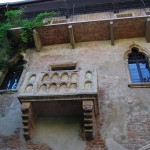VERONA (ITALY)
Verona is a city in the north-east of Italy, in Veneto region, the administrative center of the homonymic province. As of 2004, the population of Verona is 259,000 people. The city is located on the Adige River.
Verona is annually visited by hundreds of thousands of tourists including many foreigners because of its places of note and different annual activities such as the opening of the Opera season.
The city owes its historical monuments and economical significance to its geographical location.
Saint Xenon is believed to be the patron of the city. The city day is May 21st.
Situated 59 meters above the sea level, the city lies alongside the banks of the Adige River – 30 kilometers east of the Garda Lake. Because of that location the city was regularly flooded until 1956 — the year when Mori-Torbole tunnel was built, through which 500 cubic meters of water from the Adige River passes into the Garda Lake when there is a danger of a flood. The tunnel diminished the risk of flood from one time in seventy years to one time in two hundred years.
In ancient times, the city was a key center of the transport system in the north-east of the country. In Roman times, it was, in fact, the place where the four roads crossed: Gallica, Claudia Augusta, Vicum Veronensium and Postoina. Even today Verona is a crucial geographic knot of automobile and railroad roads.
In the scale of seismic danger, Verona is classified in the third zone (of low seismic danger).
Verona’s climate varies very much throughout the year because the Garda Lake with its high humidity and temperature is next to it. It is the high humidity of the air in wintertime that causes frequent mists that mainly occur after sunset and until late morning. The mean temperature of July is above 24 °C, while the mean temperature of January is around 1 °C.
The main quantity of precipitation falls on during the period of time from the end of April until the beginning of June and from October until the beginning of November, its highest point being in August. Wintertime, from the end of November until March, is less rainy — over 50mm of precipitation per month in average.
Verona was a location of settlements of people since pre-historic times in several inhabited places built by the Adige River. Scientists today argue about the time when the first settlement in the region was founded; most likely, it happened under Titus Livius. There are other theories about Etruscan origin of early settlements, and the hypothesis stating that the city was founded by indigenous population Euganei.
But only since the foundation of a Roman colony in these places in 89 B.C. the period of the city’s flourishing started. Out of small and unknown settlements the Romans built a masterpiece of art by constructing huge buildings-monuments, some of which can be seen even today. The city in III century A.D. was used as an army base against the Barbarians. The city thereafter was enlarged and strengthened by Galileo, who extended the city walls.

